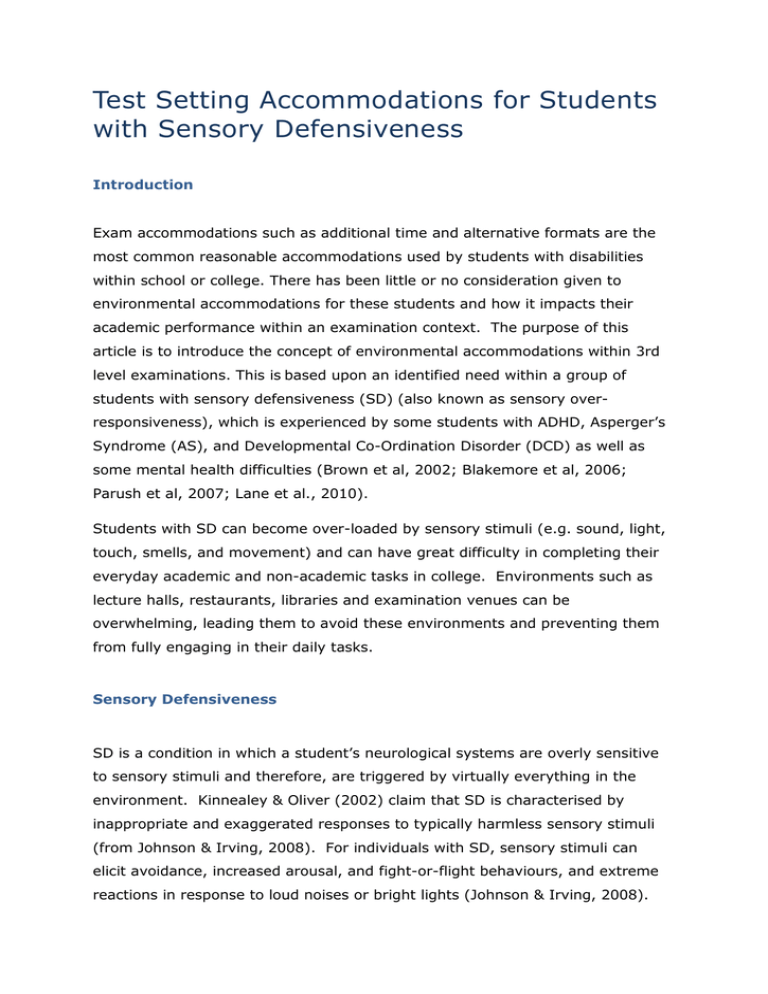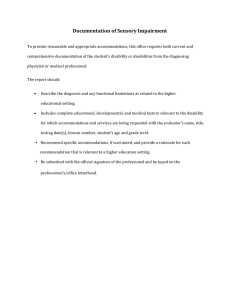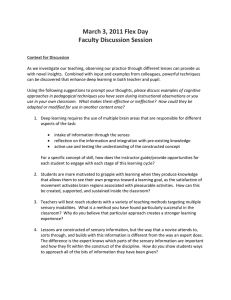Test Setting Accommodations for Students with Sensory Defensiveness - Full paper
advertisement

Test Setting Accommodations for Students with Sensory Defensiveness Introduction Exam accommodations such as additional time and alternative formats are the most common reasonable accommodations used by students with disabilities within school or college. There has been little or no consideration given to environmental accommodations for these students and how it impacts their academic performance within an examination context. The purpose of this article is to introduce the concept of environmental accommodations within 3rd level examinations. This is based upon an identified need within a group of students with sensory defensiveness (SD) (also known as sensory overresponsiveness), which is experienced by some students with ADHD, Asperger’s Syndrome (AS), and Developmental Co-Ordination Disorder (DCD) as well as some mental health difficulties (Brown et al, 2002; Blakemore et al, 2006; Parush et al, 2007; Lane et al., 2010). Students with SD can become over-loaded by sensory stimuli (e.g. sound, light, touch, smells, and movement) and can have great difficulty in completing their everyday academic and non-academic tasks in college. Environments such as lecture halls, restaurants, libraries and examination venues can be overwhelming, leading them to avoid these environments and preventing them from fully engaging in their daily tasks. Sensory Defensiveness SD is a condition in which a student’s neurological systems are overly sensitive to sensory stimuli and therefore, are triggered by virtually everything in the environment. Kinnealey & Oliver (2002) claim that SD is characterised by inappropriate and exaggerated responses to typically harmless sensory stimuli (from Johnson & Irving, 2008). For individuals with SD, sensory stimuli can elicit avoidance, increased arousal, and fight-or-flight behaviours, and extreme reactions in response to loud noises or bright lights (Johnson & Irving, 2008). Unexpected and unpredictable stimuli are most likely to cause a reaction, and behavioural reactions may increase or intensify over time with repeated exposures to uncomfortable stimuli (Johnson & Irving, 2008). Adults with SD report more anxiety and depression (Kinneally & Fuiek, 1999; Batya Engel-Yeger & Dunn, 2011) and Ma (2006) claims that they may have fewer social supports to assist in dealing with these difficulties (from Johnson & Irving, 2008). Students with SD may experience difficulty in filtering out various sensory stimuli from their environment. Many of these students choose to study at home or in low distraction environments and then have great difficulty in maintaining concentration in the exam environment. Dunn (1999) claims that people with atypical sensory processing may display exceedingly high or low thresholds to sensory information. Such individuals require either more sensory information or much less than others; therefore the ability to attend and focus is affected, and they are either under-responsive or over-responsive to sensory input or environmental stimuli. Although behaviours indicative of SD have been more often studied in children, there is an increasing focus on the impact of this disorder in adults. Test Setting Accommodations Providing test accommodations to qualified individuals is designed to promote fairness in testing and lead to accurate interpretation of the examinee’s test scores (Sireci & Pitoniak, 2006). Accommodations are intended to provide equal access by removing unnecessary barriers. Test Setting Accommodations involve altering the testing environment (e.g. a private room, a quiet room, or a small group setting) (Gregg, 2009). Although the use of test setting accommodations is often recommended by professionals for adolescents and adult populations with ADHD, only anecdotal evidence is available to support the effectiveness of such accommodations in practice (Gregg, 2009). For the majority of the students, the provision of extra time in examinations is a very effective form of reasonable accommodation offered in Higher Education Institutes (HEI). However, for students with SD, the provision of extra time within an unsuitable venue will not enable them to engage with their examinations. The provision of appropriate test setting accommodations as outlined below, used in conjunction with individual strategies such as the use of earplugs / noise cancelling earphones can help to remove this barrier to engaging in the examination process. Exam Survey In February 2011, a survey was conducted to allow students registered with the Disability Service in Trinity College Dublin to give feedback on their experience of taking examinations in Trinity College. The aim of the survey was to gain feedback from students with examination accommodations to determine if any changes were required. 102 students completed the survey and while the feedback from the majority of students was positive, results indicated that the experience of some students is very different to this majority. The responses to the survey suggested that a sizeable minority experience exam venues as ‘poor’ or ‘unacceptable’. The majority of these comments were made by students who have disabilities where distractibility and sensory processing difficulties are predominant issues. Difficulties experienced most frequently were: Noise (within and outside the reasonable accommodation venues). Distractions (other students, overcrowding, exams ending at different times, invigilator announcements). Temperature (very cold at end of the first term examinations) Students with ADHD expressed that the high level of people coming and going from the venue caused distraction. Students with Dyspraxia experienced sensory difficulties with noise, temperature and light. Some Comments from this Survey: “The room I was in had approximately 80 people in it and was very very intimidating. Very large room on the 3rd floor.” [...] Too many people and too many distractions.” “distracting as people leave before me and I then can’t concentrate” “Concentration: I find it difficult to concentrate in larger venues with large groups of people.” “Noise levels and other students can be distracting.” “I get far too distracted by other students.” Although all of this group of students were not assessed and confirmed to be sensory defensive, the fact that they report such difficulty filtering out sensory stimuli in environments where most of the students reported no difficulty, suggests that they may be sensitive to certain sensory stimuli. Based upon these findings, the reported difficulties of these students in meetings with Disability Service (DS) staff, and upon the literature in the areas of ADHD, AS and SD, we hypothesised that providing extra time within a group venue of 30 – 60 students (Figure 1) would not be providing accommodations that promoted fairness. Figure 1: Group Venue As a result, two Occupational Therapists working within an Occupational Therapy service within the Disability Service in TCD called Unilink completed an audit of the exam venues used for students receiving exam accommodations. This audit looked at current venues under the headings of room capacity/ proximity of students to each other, auditory distractions (within and outside the venue), visual distractions, and lighting. Following this audit, recommendations were made to the Examinations Office for the establishment of low-distraction venues on a pilot basis. Criteria were established for choosing venues (see table 1 below) and recommendations were made for the setup of the venues (see table 2 below). Criteria for Room Selection; a) Exam rooms to be located away from main road side the building to reduce noise from traffic. b) Exam rooms to have concrete walls and doubled glazed windows for increased sound proofing. c) Exam rooms to be located away from departmental offices, toilets, lockers, stairwells and common seating areas. d) Exam venues to be well ventilated so that windows or doors do not have to be opened during exams. e) Students using a computer but who also require test setting accommodations should have an individual venue. Table 1: Criteria for Room Selection Recommendations for the Setup of Low-Distraction Venues; a) Numbers of students within the venue to be restricted to allow extra space between desks. b) Desks should be placed facing the wall within smaller venues. Desks should be placed against blank walls. c) All unnecessary materials should be placed outside the room for the duration of the examination. These include boxes, audio/visual equipment, unused chairs and tables etc. d) Blinds should be used in exam rooms to control the amount of natural light. e) All computers and Audio-Visual Equipment must be switched off in the room. f) Invigilators to be made aware of the need to reduce auditory distractions such as newspapers, laptops, eating etc. g) If there are a number of students sitting their examinations within one room, it essential that auditory distractions, such as moving about in chairs, etc.; are kept to a minimum so as not to distract the other students. h) Cleaning staff / Director of Buildings should be informed of the different exam venues, dates and times of examinations in order to avoid unnecessary external noise. i) Earplugs or noise-cancelling earphones to be provided within the room. Table 2: Recommendations for the Setup of Low-Distraction Venues Two venues were established (one with four seats and one with three seats) as well as two individual venues for students using computers whom also required test setting accommodations. These venues were located in an area of the Arts Building where the least number of offices were located. Figures 2: The Four Seat Low-Distraction Venue Assessment Students who were possibly appropriate for using these low distraction venues were assessed by the Occupational Therapists within the Unilink Service using the Adolescent / Adult Sensory Profile (Brown & Dunn, 2002). If results from this assessment show the student to be in the ‘sensory sensitive’ or ‘sensation avoiding’ clusters, then the use of this test setting accommodation was recommended to the student. Whether or not to avail of this accommodation was of course still the student’s decision. Student Education about SD and Preparation for Using the Test Setting Accommodations Consistent with the philosophy within the Disability Service in Trinity, of student’s developing self-management strategies, students were educated within Unilink about sensory defensiveness and worked collaboratively with their Occupational Therapist to develop strategies to help manage it within the college environment. Initially, the Occupational Therapist provided information to the student about sensory processing and sensory defensiveness and then the student worked with their Occupational Therapist to identify their sensory preferences and to develop strategies that would facilitate them in functioning within lectures, libraries and other college environments. The process took place throughout the academic year but in the lead up to examinations, students and Occupational Therapist met to discuss the examination venue set-up and any alterations that were required. Students were brought to the venue in the weeks leading up to the examination and mock exams were run in the venue. Feedback on the Test Setting Accommodations During the examination period, staff from the Disability Service observed the venues, invigilators completed questionnaires during each examination and students were asked for feedback by email following the examination period. Sample of Email Responses from Students using the Low-Distraction Venues; 1. How did you find the setup of the room? o Fine, very accommodating o It was great as it really helped minimise distraction levels and it was easier for me to concentrate. o Perfect. I was able to put the table up against a wall at an angle so that I didn't see the invigilator. I also put my hood up for some of the exams which worked well. o I had 2 exams. They both went well. The room was perfect. o The room was fantastic. It went well and glad it is over now. 2. Would you prefer to have the desks facing against the wall or facing out into the room? o o o o Wall definitely. Definitely the desk facing the wall, as there was nothing to distract you from your exam. Facing against the wall. Room was perfect, I didn't get distracted at all, desk facing the wall worked well. 3. Was there adequate room between the desks? o o o o Yes, the space between the desks was perfect. Yeah it was fine. Yes. I was on my own. 4. Were there any distractions from within the room? o o o o The first invigilator was a bit loud but I was wearing earplugs so it didn't really matter that much. Also, one examiner was texting, on the computer which was distracting at times( the noise of the buttons on the phone and keyboard ) None. No 5. Were there any distractions from outside the room? o The location of the room was sometimes distracting as there is an office beside it. The man was often chatting on the phone which was heard in the exam room. o Not really but I did prefer when the invigilator closed the door. If they opened it I usually asked them to close it. o Sometimes people not sitting the exam were coming in and out, and occasionally the supervisor left to answer their phone. o Yes, at times. 6. Did you use earplugs? o I did indeed. o No. o No. o I did use ear plugs on the first day when the man next door was very loud. 7. Was the o o o o lighting appropriate in the room? Yes it was fine. Yeah, perfect. The lighting was perfect, would not change. Yes. 8. How would you set up the room differently in future? o o o o It was adequately set up for me. I thought the lay out was perfect, no change needed. It was an excellent service, and really helped me to relax into the exams. I think it was perfect. If I think of anything I'll let you know. Table 3: Sample of Email Responses from Students using the Low-Distraction Venues Conclusion The feedback was very positive for the setup of the low-distraction venues, but some student’s sensitivity to auditory and visual distractions is still clear from the comments, even within the low distraction environment that we had established. Although these examination venues appear to be an improvement on the group examination venues traditionally used with these students, the location of the venue needs to be reviewed and the setup refined based upon the student and invigilator feedback. The need to recognise and assess sensory defensiveness in the student and use appropriate accommodations to help these student’s engage in their examinations has been highlighted within this article. The pilot shows promising results and the venues will be used over the coming academic year and their effectiveness further assessed. Authors: Kieran Lewis, Occupational Therapist, Unilink Service. Dr Clodagh Nolan, Unilink Service Director. Declan Treanor, Disability Service Director, T.C.D. Contact: Kieran Lewis Email: klewis@tcd.ie For more information on Unilink: http://www.tcd.ie/disability/TServices/Unilink/index.php References: Blakemore, S.J. Tavassolli, T., Calo, S., Thomas, R.M. Catmir, C., Frith, U., & Haggard, P. (2006). Tactile Sensitivity in Asperger Syndrome. Brain and Cognition, 61, 5-13. Brown, C., Cromwell, R.L., Filion, D, Dunn, W., & Tollefson, N. (2002). Sensory Processing in Schizophrenia: Missing and Avoiding Information. Schizophrenia Research, 55 (1-2), 187-195. Brown, C. & Dunn, W. (2002) Adult/Adolescent Sensory Profile: User's Manual. San Antonio, TX: Psychological Corporation. Dunn, W. (1999). The Sensory Profile. San Antonio, TX: Psychological Corp. Engel-Yeger, B. & Dunn, W. (2011) The Relationship Between Sensory Processing Difficulties and Anxiety Level of Healthy Adults. British Journal of Occupational Therapy. 74 (5), 210-216. Gregg, N. (2009) Adolescents and Adults with Learning Disabilities and ADHD: Assessment and Accommodation. New York: Guilford Press. Johnson, M.E. & Irving, R. (2008). Implications of Sensory Defensiveness in a College Population. Sensory Integration Quarterly / American Occupational Therapy Association. 31 (2), 1-3. Kinnealey, M. & Fuiek, M. (1999). The Relationship between Sensory Defensiveness, Anxiety, Depression, and the Perception of Pain in Adults. Occupational Therapy International. 6, 195-296. Lane, S.J., Reynolds, S., & Thacker, L. (2010) Sensory Over-Responsivity and ADHD: Differentiating Using Electrodermal Responses, Cortisol, and Anxiety. Frontiers in Integrative Neuroscience. (4), 1-11. Law, M., Cooper, B., Strong, S., Stewart, D., Rigby, P. & Letts, L. (1996). The Person-Environment-Occupation Model: A Transactive Approach to Occupational Performance. Canadian Journal of Occupational Therapy, 63 (1), 9-23. Mangeot, S.D., Miller, L.J., McIntosh, D.N., McGrath-Clarke, J., Simon, J., Hagerman, R.J., Goldson, E. (2001) Sensory modulation dysfunction in children with attention-deficit-hyperactivity disorder. Developmental Medicine & Child Neurology, 43:399-406 Miller, L. J. (2006). Sensational kids: Help and hope for children with sensory processing disorder. New York: Putnam. Miller, L.J., Anzalone, M.E., Lane, S.J., Cermak, S.A., Osten, E.T. (2007) Concept Evolution in Sensory Integration: A Proposed Nosology for Diagnosis. American Journal of Occupational Therapy, 61(2), 135-140. Murray, M.; Hudson-Baker, P.; Murray-Slutsky, C.; Paris, B. (2009) Strategies for Supporting the Sensory-Based Learner. Preventing School Failure: Alternative Education for Children and Youth, Vol. 53 (4) (pp.244-251) Parush, S., Sohmer, H., Steinberg, A., Kaitz, M. (2007). Somatosensory function in boys with ADHD and tactile defensiveness. Physiology & Behaviour. 90, 553–558. Sireci, S. & Pitoniak, M. (2006). Assessment Accommodations. What Have we Learned from Research? Paper presented at workshop of Accommodating Students with Disabilities on State Assessment: What Works? Savannah, GA. Retrieved Sept 2, 2011 from www.ets.org/Media/Research/conf_accomm2006_sireci.ppt





